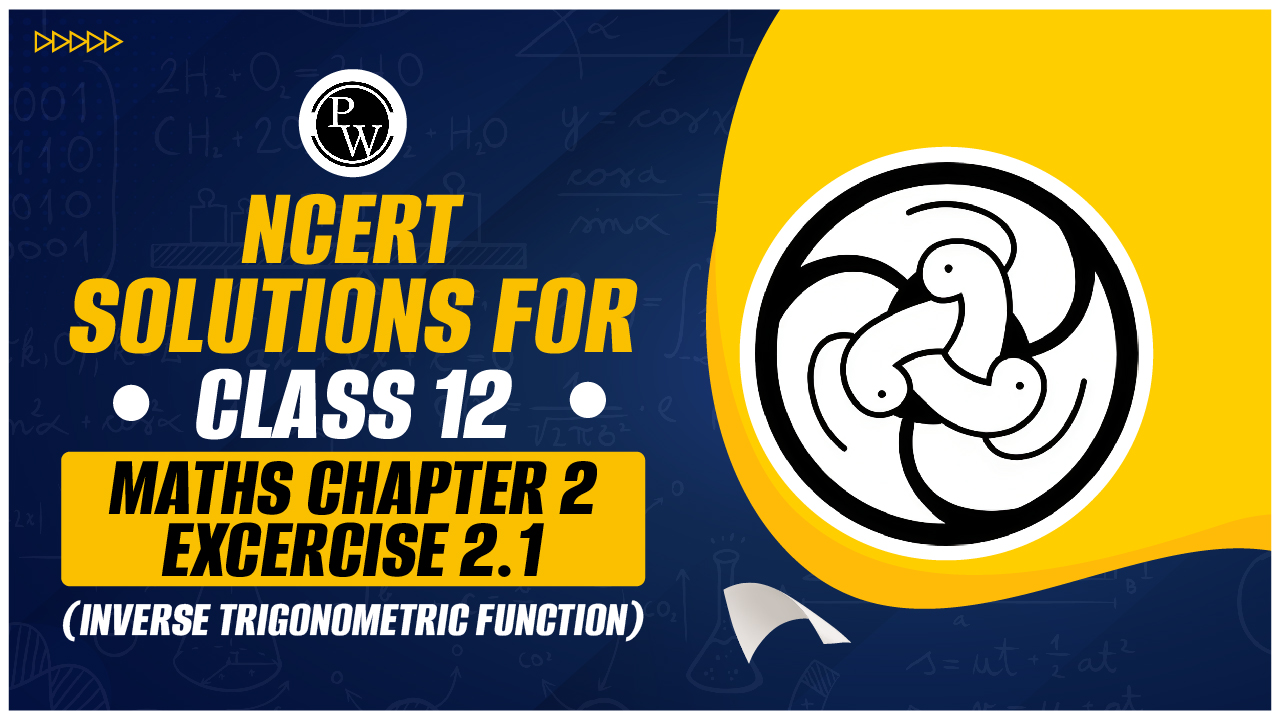NCERT Solutions for Class 12 Maths Chapter 2 Exercise 2.1 (Inverse Trigonometric Function)

Class 12 Maths Chapter 2 Exercise 2.1 (Inverse Trigonometric Function):- This exercise covers essential topics related to Inverse Trigonometric Functions. The NCERT Solutions for Class 12 Maths Chapter 2 Exercise 2.1 on Inverse Trigonometric Functions have been meticulously prepared by the academic team at Physics Wallah. We have developed comprehensive solutions for all exercises in Chapter 2, including detailed step-by-step explanations for each question in Exercise 2.1.
Check out: Class 12 Mathematics Book
Class 12 Maths Chapter 2 Exercise 2.1 (Inverse Trigonometric Function)
Class 12 Maths Chapter 2 covers Inverse Trigonometric Functions, which are essential for understanding the inverses of sine, cosine, and other trigonometric functions. Go through the Class 12 Maths Chapter 2 Exercise 2.1 (Inverse Trigonometric Function) from below.
Question1. Find the principal value of sin-1 (-1/2)
Solution :
Question2. cos-1(√3/2)
Solution :
Question3. cosec-1(2)
Solution :
Check out: CBSE Class 12th Books
Question4. tan-1(-√3)
Solution :
Question5. cos-1(-1/2)
Solution :
Question6. tan-1 (-1)
Solution :
Question7. sec-1(2√3)
Solution :
Question8. cot-1(√3)
Solution :
Question9. cos-1(-1/√2)
Solution :
Question10. cosec-1(-√2)
Solution :
Find the value of the following:
Check out: Class 12th Sample Papers
Question11.
Solution :
Question12.
Solution :
Question13.
Solution :
Therefore, option (B) is correct.
Question14.
Solution :
Therefore, option (B) is correct.
Check out: Class 12th Question Banks
Class 12 Maths Chapter 2 Exercise 2.1 Inverse Trigonometric Function Summary
-
This exercise introduces inverse trigonometric functions, which are essentially the reverse of trigonometric functions (sine, cosine, tangent, etc.).
-
They help you find the angle measure when given the trigonometric ratio.
-
Inverse trigonometric functions are denoted with superscript "-1". For example, sin^-1(x) represents the inverse sine function, commonly written as sin⁻¹(x) or arcsin(x).
-
Understanding the distinction between inverse trigonometric functions (e.g., sin⁻¹(x)) and the reciprocal of a trigonometric function (e.g., 1/sin(x)).
-
Recognizing the restricted domains for inverse trigonometric functions to ensure a unique output (angle).
-
Sine inverse (sin⁻¹(x)): -1 ≤ x ≤ 1
-
Cosine inverse (cos⁻¹(x)): -1 ≤ x ≤ 1
-
Tangent inverse (tan⁻¹(x)): All real numbers
Class 12 Maths Chapter 2 Exercise 2.1 Inverse Trigonometric Function FAQS
Q1. How do you find the principal value of an inverse trigonometric function?
Ans. To find the principal value, you need to determine the angle that lies within the defined principal range for each trigonometric function (e.g., for Sin −1 (𝑥)sin −1 (x), the range is [−𝜋/2,𝜋/2] [−π/2,π/2]).
Q2. What is the principal value of sin−1(1/2)\sin^{-1}(1/2)sin−1(1/2)?
Ans. The principal value of sin−1(1/2)\sin^{-1}(1/2)sin−1(1/2) is π/6\pi/6π/6 or 30 degrees.
Q3. What are the ranges for principal values of inverse trigonometric functions?
Ans. The ranges are:
-
sin−1(x)\sin^{-1}(x)sin−1(x): [−π/2,π/2][- \pi/2, \pi/2][−π/2,π/2]
-
cos−1(x)\cos^{-1}(x)cos−1(x): [0,π][0, \pi][0,π]
-
tan−1(x)\tan^{-1}(x)tan−1(x): (−π/2,π/2)(- \pi/2, \pi/2)(−π/2,π/2)
-
cot−1(x)\cot^{-1}(x)cot−1(x): (0,π)(0, \pi)(0,π)
-
sec−1(x)\sec^{-1}(x)sec−1(x): [0,π][0, \pi][0,π], excluding π/2\pi/2π/2
-
csc−1(x)\csc^{-1}(x)csc−1(x): [−π/2,π/2][- \pi/2, \pi/2][−π/2,π/2], excluding 0
Q4. How do inverse trigonometric functions apply in real-life scenarios?
Ans. Inverse trigonometric functions are used in engineering, physics, and navigation to determine angles and distances based on trigonometric ratios.
Q5. What is the principal value of cos−1(0)\cos^{-1}(0)cos−1(0)?
Ans. The principal value of cos−1(0)\cos^{-1}(0)cos−1(0) is π/2\pi/2π/2 or 90 degrees.









